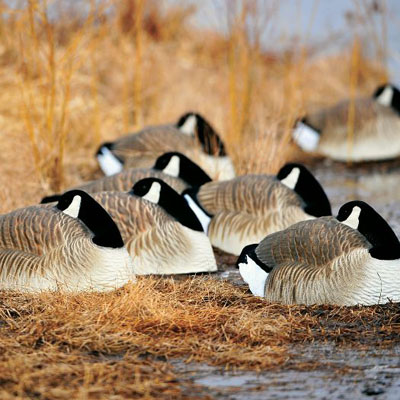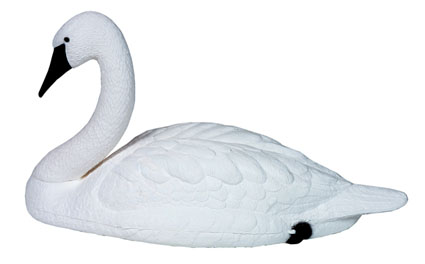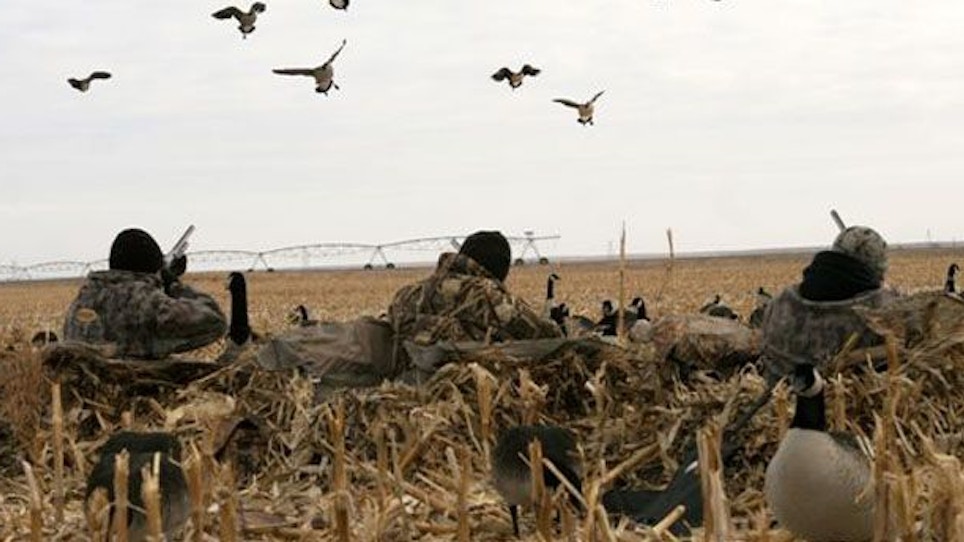All confidence decoys have one basic purpose: to create an embellished sense of realism that gives ducks confidence in their decision to land in your decoy spread. Each confidence decoy is an added detail that helps relay the message, “It’s safe here. Come on down.”
 Geese don’t sleep unless they are completely at ease, so adding a few sleeper shells like these can help draw ducks to your spread. Courtesy of fabrand.com. |
In the strictest sense of the term, a confidence decoy is an imitation of a species you probably don’t intend to shoot, but one normally found among a contented flock of waterfowl. They typically represent wary water or wading birds such as geese, herons, coots, sea gulls and swans. Other species occasionally used include cranes, egrets, shorebirds, mergansers, loons and even cormorants.
Geese
Geese are the most commonly used confidence decoys. Waterfowlers nationwide employ them to enhance their duck decoy spreads.
White-fronted and snow goose representations aren’t often used because these species seldom mingle as singles or small groups near duck flocks. Canada geese, on the other hand, often feed alongside duck flocks in pairs or groups. Consequently, Canada goose decoys make good confidence decoys.
Canadas are wary birds, so their presence in a rig indicates all is okay. Their large size also makes them visible from greater distance, adding visibility to the spread. Place them in pairs here and there on the upwind, outside edge of the duck decoys (on shore or in the water). Standing, floating and silhouette models are available.
Coots
You might get teased mercilessly by your friends if you add water chickens to your spread, but coot decoys are good confidence decoys. They were commonly added to decoy spreads of nineteenth-century hunters, and because they’re readily available today, enterprising waterfowlers still use them. If coots live where you hunt, consider setting at least a dozen coot decoys to the side of your duck decoys.
Herons, Egrets And Cranes
Great blue herons are among the wariest birds. Consequently, confidence decoys representing this species are among those most used by waterfowlers. One or two of these decoys placed 50 to 100 yards from your duck decoys creates an appearance of safety for passing duck flocks.
Some hunters prefer egret decoys, which are white, saying they are more visible to ducks. And in states where sandhill cranes are common, hunters often add crane decoys to their spreads.
Sea Gulls
Sea gull decoys might be the oldest confidence decoys still in use. Hunters in coastal areas of the East and North used them more than a century ago. Usually one or two gulls were positioned on the edge of the set to give it a natural look, but some hunters placed them right on top of their sinkboxes or lined them up atop their blinds.
Sea gull confidence decoys still remain popular with coastal hunters hoping to sneak under the radar of wary divers and sea ducks. Hunters on inland water bodies use them only rarely, but a few gulls added to a spread on one of the many lakes or rivers frequented by these birds would probably prove useful. Standing and floating models are available.
Swans
 Swan imitations are large, thus providing added visual attraction to the hunter’s decoy spread. Courtesy of Carrylitedecoys.com. |
Swans have become increasingly abundant in several states, prompting some hunters to add swan decoys to their spreads with reported success. Because manufactured swan decoys tend to be relatively expensive, some hunters paint Canada goose decoys white to represent swans. Realistic swan decoys are available, however.
Swan decoys, like goose decoys, are large, thus making your spread more visible to high-flying or distant ducks. One or two placed a few yards from the edge of your regular spread might draw ducks that would otherwise pass. If you hope to kill geese as well, however, hunters in the know say to skip the swan decoys. Geese apparently won’t land when swans are nearby.
Crows
It’s difficult to trace the evolution of the crow decoy as a confidence decoy for ducks. But at some point, an enterprising waterfowler must have noticed crows feeding near his duck decoys and decided to add a few crow dekes to the mix. They worked, and word spread that having a few wary-crow imitations in the bushes and along the shore could help make a setup appear safer and more realistic. Many hunters swear by their effectiveness. And because crow decoys are relatively inexpensive, they’re often the confidence decoy of choice for frugal hunters.
Others
Cormorant decoys are available today as well, and considering the proliferation of these water birds on many waters, one or two dekes placed in key spots might be worth trying. At the very least, their large size (about 32 inches beak to tail) will add visibility to your spread. And if the U.S. Fish and Wildlife Service ever allows hunters to shoot these problem birds, you’ll have a head start on your cormorant-hunting buddies!
At least one retailer also offers decoys resembling shorebirds such as snipe, curlews and plovers. Those who hunt coastal areas or marshes where shorebirds are common could benefit from the addition of a few of these inexpensive dekes around their spread.
Summary
Confidence decoys have been used for more than a century, a fact that should convince you to give them a try. At the very least, they give hunters more confidence in their ability to create decoy spreads that looks totally real to ducks. And that’s reason enough to give them a try. You’ll be glad you did.






